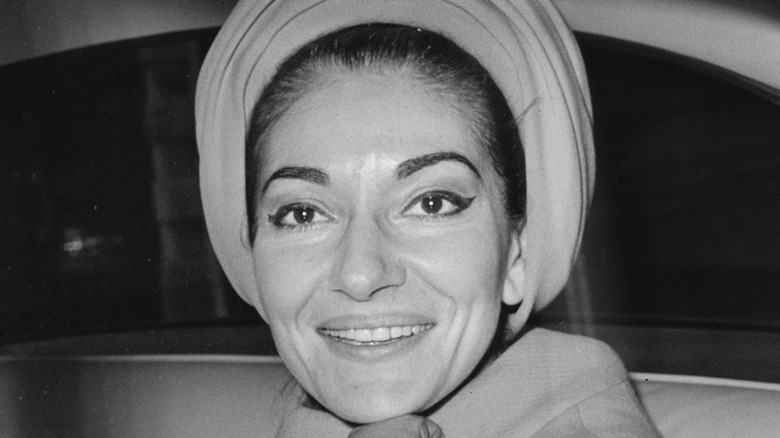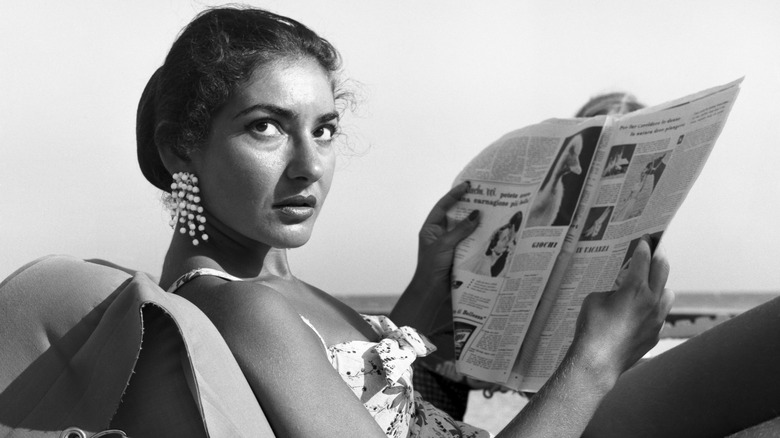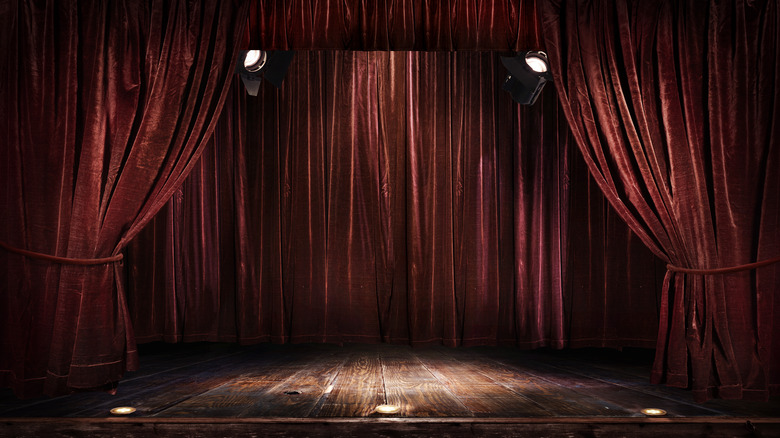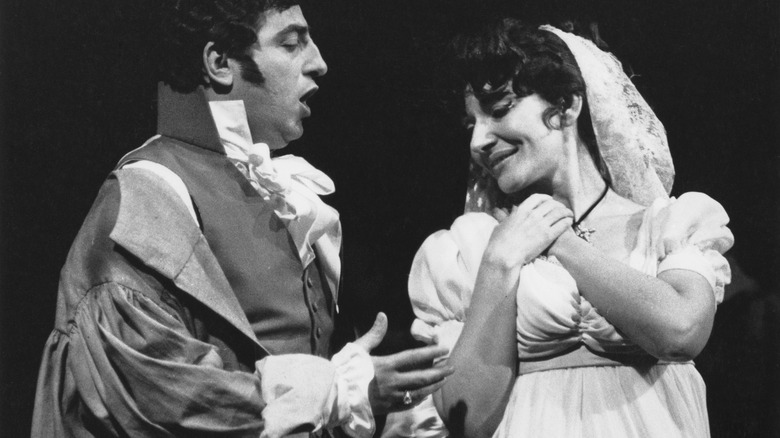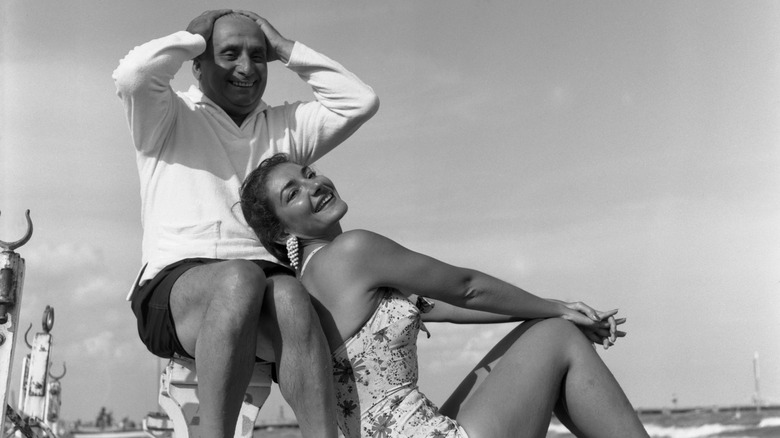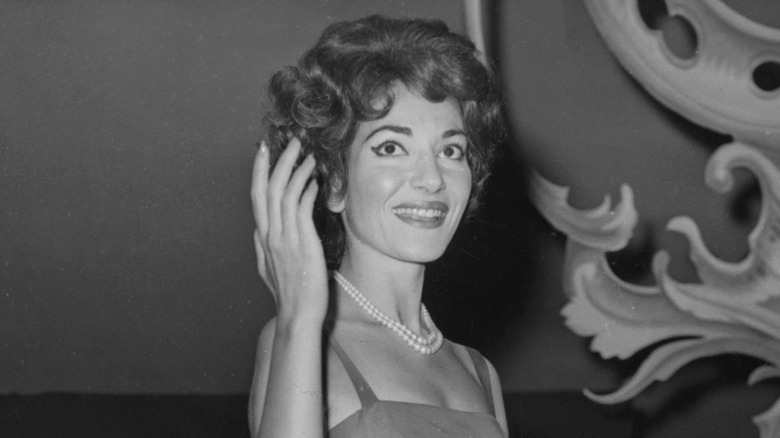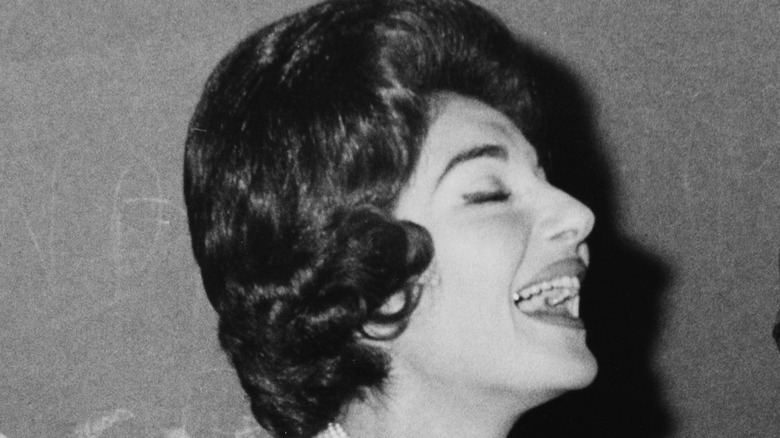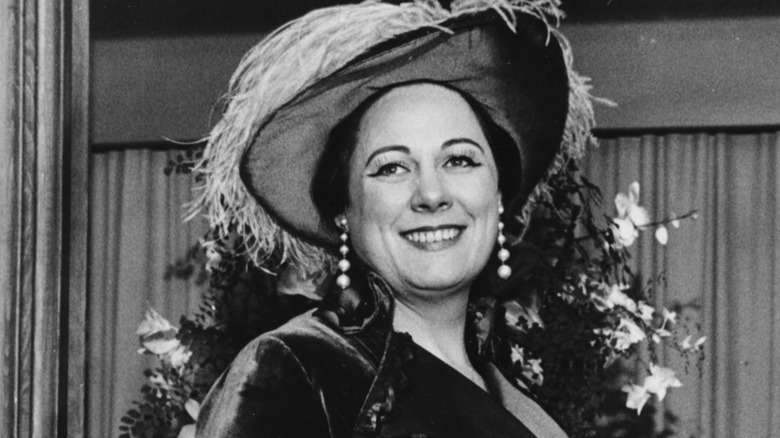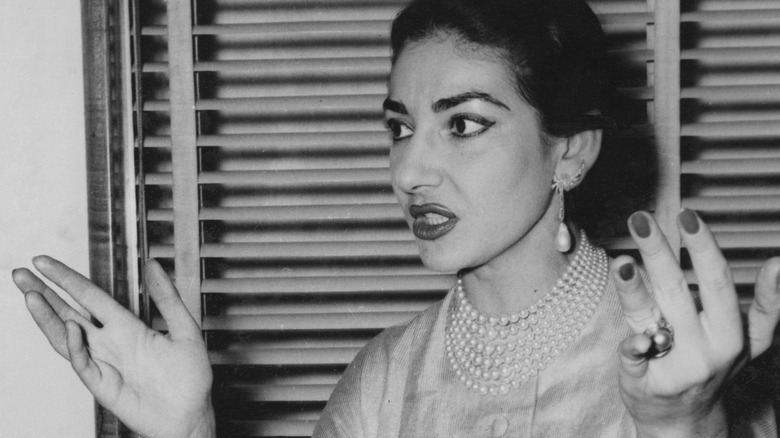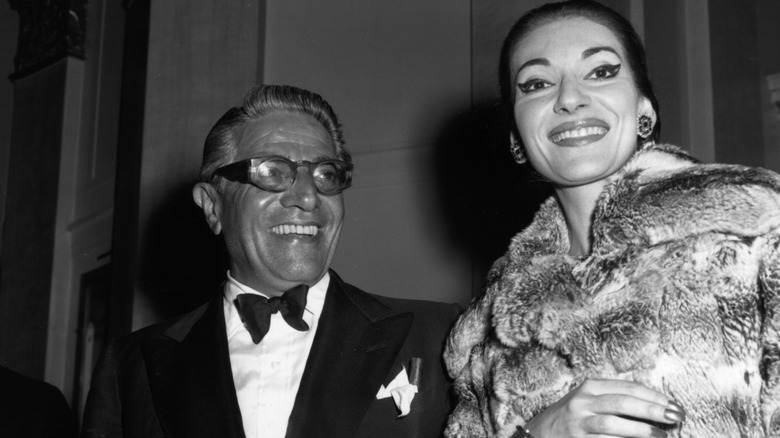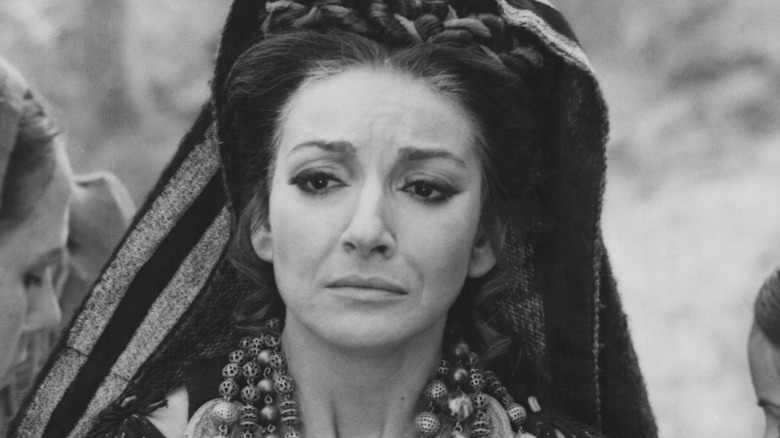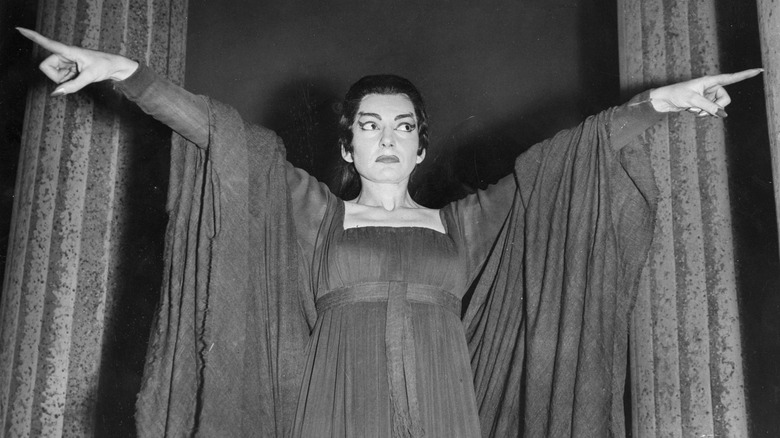The Tragic True Story Of Maria Callas
Greek-American soprano Maria Callas was born in 1923 and took the operatic world by storm with her intensely dramatic mid-century portrayals of classical music's most famed leading ladies, from Medea to Norma and Aida. She performed in 1941's "Boccaccio" with the Royal Opera of Athens, which helped her garner her first significant role in "Tosca." By 1947, she officially debuted in Italy at the Verona Arena. But one of her most notable roles would come in the 1954 production of "Norma."
During her musical career, Callas won acclaim for her electrifying interpretations, one-of-a-kind voice, and incredible range. Yet, time would not deal kindly with her. She enjoyed her most solid vocalizations in the early 1950s, but an early and perceptible decline started near the end of the same decade (via NPR).
Some critics blamed the change in her voice on extreme dieting and weight loss. In contrast, others attributed it to a lack of practice after commencing a turbulent and exhausting relationship with Aristotle Onassis, a Greek shipping magnate. Today, researchers have taken a new perspective based on the recent disclosure of a rare diagnosis she received in 1975. Dead in 1977 from a heart attack, as reported by The New York Times, she passed away in Paris at 53 years old, bringing to a close a life filled with heartbreak.
Her parents had an unhappy marriage
On December 3, 1923, Maria Cecilia Sophia Anna Kalogeropoulos came kicking and screaming into the world at the Flower hospital and Fifth Avenue in Manhattan. The daughter of recent Greek immigrants to the United States, George and Evangelia "Litza" Dimitriadou, Maria Callas proved a painfully unwelcome addition. After arriving in America, George had shortened the family's name to Callas (via Encyclopedia), but other adjustments to the American way of life proved more difficult.
To make matters worse, the problems brewing in the couple's marriage had started years before the newborn's birth. Litza's father advised her against marrying George before the couple's nuptials. He firmly believed George could never make his daughter happy. Very early in their marriage, Litza came to the same unfortunate conclusion. George proved laidback, easy-going, and prone to infidelities. Conversely, Litza was highly ambitious, volatile, and obsessed with social climbing.
Despite George's natural good looks and career as a pharmacist, he never shared his wife's desire for luxury or social distinction. As he established a career and enjoyed greater affluence and community standing, he dawdled in a series of affairs that left Litza the equivalent of an "explosive martyr," according to Arianna Huffington's book, "Maria Callas: The Woman Behind the Legend." Maria had just entered a veritable powder keg of a family.
Maria Callas' older brother died young
The Callas' first two children proved a healing balm for their troubled marriage. At the age of 18, Litza Callas gave birth to the couple's first child, Jackie, a preternaturally beautiful girl who would grow into an elegant woman. Three years later, in 1920, the Callas' welcomed a much-desired son into the mix, Vasily. Vasily proved precocious and talented. By the age of 3, he could play basic songs on his mother's piano, and he read well. But tragedy stalked the family, forever destroying the tiny bit of happiness George and Litza Callas relished.
In 1923, typhoid fever blasted through Meligala, Greece, where the Callas' lived, taking their precious 3-year-old son as one of its first victims. Vasily's death dealt the already unhappy marriage between George and Litza a significant blow. The couple handled the tragedy in different ways. Litza became pregnant again, and she prayed fervently for a son to replace Vasily, even determining to call him Petros after her father. At the same time, the Callas family patriarch decided to sell his pharmacy and relocate the family to the United States.
When he broke the news to his wife, pregnant at the time, he'd already sold his business and bought passage to New York. The dramatic decision occurred without consulting his wife, which further strained the couple's already fraught relationship. Nevertheless, both hoped the birth of a son would heal the family, who arrived in America in August 1923 (via Encyclopedia).
Her mother rejected her because she wanted a son
Litza Callas' obsession with having a son to replace her precious Vasily crossed the transatlantic passage with the troubled family. She would later write, "Ever since Vasily's death, I had prayed for another son to fill the empty place in my heart" (via Anne Edwards). In keeping with her blind faith, Litza knit a collection of blue baby caps and sweaters and placed every hope on her coming baby's gender. During one of the biggest snowstorms ever to besiege New York, Maria Callas was born. Litza didn't mask her disappointment at her daughter's arrival.
She refused to see her newborn or hold her for four interminable days before doctors could persuade her to give her daughter a second glance and a name. This initial reception would underscore the mother-daughter relationship for the rest of Maria's life, according to Neokosmos. What's more, the birth of another daughter further eroded the fragile relationship between George and Litza Callas. The last few nails in the coffin came with the stock market crash of 1929 and the loss of George's pharmaceutical business.
Forced to travel as a salesman, George would never recover his relationship with Litza, who threw herself increasingly into an old fantasy, that of the stage. But this time, she decided to use her youngest daughter Maria as a stepping stone to achieving the artistic renown she long craved.
Maria Callas' mother was a notorious stage mom
Litza Callas came from the Dimitriadis line, an upper-middle-class family proud of its patrician heritage and history of artistic family members, including musicians and a poet. Her father served as an army commander during the Balkan War and earned the moniker the "Singing Commander" because of his exceptional voice. Her family history contributed to Litza's desire for a career on stage. But this dream went far beyond a youthful fantasy. Anne Edwards notes in "Maria Callas: An Intimate Biography" that Litza was "fanatical about anything to do with the stage."
Litza's unhappy marriage and lack of fulfillment in life would have negative consequences for Maria Callas, especially once Litza concluded that her young daughter had inherited her father's talent for singing (via Encyclopedia). By age 7, Maria started classical piano lessons, notes Biography, which were soon eclipsed by her singing, performing for classmates at public school. In 1937, George and Litza Callas officially separated, and Litza moved her daughters to Athens, where she enrolled Maria in singing lessons at the Royal Academy of Music. Predictably, Litza evolved into a notorious stage mom. She pressured Maria from an early age to perform for money, robbing her daughter of a childhood (via Great Opera Singers).
Maria's transformation from a kid who enjoyed singing to an international talent occurred over the next few years. By 15, she performed in "Cavalleria Rusticana" as Santuzza, and a few years later, she debuted with the Athens Opera. Despite these triumphs, Maria remained plagued by a sense of rejection and unworthiness.
Weight issues plagued Maria Callas' early career
Maria Callas' childhood represented the perfect storm for developing an unhealthy relationship with food. As she would later reflect, "Only when I was singing did I feel loved" (via Encyclopedia). Even as she shoved Maria onto stages at a young age, Litza Callas felt tremendous guilt about her diffident and cold parenting. These feelings may have motivated her to show affection in other ways, namely through food. Maria learned to self-soothe with meals, sometimes even eating herself to sleep.
As a result, Maria suffered from weight issues throughout her early career, exacerbated by her mother's constant comparison of her two daughters. While Litza believed Jackie Callas to embody feminine perfection, Maria received little attention, except for her budding vocal career. According to Cultura Colectiva, Maria weighed 220 pounds by her teens. She was myopic and dressed sloppily, exacerbating feelings of inferiority and inelegance.
In her memoir, "My Daughter Maria Callas," Litza would later write of her daughter's devotion to singing — "[she] practiced day and night and sometimes forgot to eat, which for Maria was miraculous" (as quoted in Encyclopedia). Critics would also begin weighing in on Maria's physique as she gained acclaim on the world stage. Following a performance of "Aida," one music critic cruelly noted, "It was difficult to discern Callas' ankles from those of the elephant in the scene." Ultimately, concerns about her singing career and her voice feeling heavy motivated Maria to go on a self-starvation regimen.
Cruel rumors about her weight loss method led to a lawsuit
Maria Callas lost over 80 pounds between 1953 and 1954. Many have likened the transformation of the obese singer into an elegant and svelte prima donna to that of the Ugly Duckling, including Paul Wink in his book, "Prima Donna: The Psychology of Maria Callas." Callas' incredible weight loss rendered her visually stunning. But it also stoked wild rumors about how she lost weight, including the urban legend of swallowing a tapeworm.
This myth still makes the internet rounds, but is there any merit to the parasitic story? Bruno Tosi, president of the International Maria Callas Association, debunked the rumor in 2006. In an interview with The Guardian, Tosi explained that Callas "did have to have treatment for worms, possibly because of her fondness for raw steak, but she dropped the weight by following a diet based on consuming iodine." The iodine diet worked, although it came with dangerous side effects like changes to her metabolism and central nervous system.
But the most troubling rumors, according to "The Autobiography of Maria Callas," involved an unscrupulous pasta company, Pantanella Pasta and Flour Factory, who saw her physical triumph as an opportunity to make money. The company claimed Callas' lost weight resulted from consuming their "physiological pasta," a claim signed by Dr. Cazzarolli, a family friend who served as best man at Callas' wedding to Giovanni Battista Meneghini. After Cazzarolli refused to publish a retraction and apology, Callas sued the company, the lawsuit of which dragged on for three years. Eventually, they published a retraction and paid for damages and legal expenses.
Maria Callas' voice represented a point of controversy
Although Maria Callas remains one of the most iconic opera singers of the 20th century, her voice had many detractors. The sound she produced in the three ranges proved so controversial it sparked countless debates.
On the one hand, critics like Walter Legge noted her possession of "the most essential ingredient for a great singer: an instantly recognizable voice" (via Snippet of History). But others, such as the Italian Rodolfo Celletti, had nothing but bad news for the soprano. Celletti wrote that her voice sounded ugly and arid. Even Callas' mentor, Tullio Serafin, got in on the nasty comments, referring to her by the pejorative "una grande vociaccia," or literally, "the great ugly voice." Perhaps saddest of all, Callas didn't enjoy the kind of voice she had. Nevertheless, it didn't stop her from filling her performances with drama and bravura.
But the famed diva contended with more than harsh words from critics. She endured performances where the audience openly laughed at her or lobbed vegetables on stage (via The Guardian). In one instance described in her autobiography, she recalled the after-effects of having bunches of turnips and radishes tossed onto the stage amid flowers and roses from admirers. "When I got home, I screamed and cried for hours, and experienced a panic at each curtain call for weeks after."
She was embroiled in a vicious operatic rivalry
The so-called operatic rivalry between Maria Callas and fellow soprano Renata Tebaldi held the media in its sway. According to Euro Arts, Callas and Tebaldi represented the two most celebrated artists of the mid-20th century. Perhaps this made a clash between "the voice of an angel" (Tebaldi) and "the tigress" (Callas) inevitable. The vast gulf between each singer's performances and public persona added more fuel to the fire.
The two performers couldn't have been more opposite if they tried, distinguished by everything from temperament to versatility. The media ate up the antagonism between the two opera stars, which famously started when Tebaldi and Callas performed in a joint recital in Rio de Janeiro, Brazil. Callas would later claim that Tebaldi took two encores after telling Callas there would be none.
But the rift in their relationship didn't reach its most vicious point until 1965 when Callas told reporters, "If the time comes when my dear friend Renata Tebaldi sings Norma or Lucia one night then Violetta, Gioconda, or Medea the next — then and only then will we be rivals. Otherwise it is like comparing champagne with cognac. No — Coca-Cola." Callas would also accuse Tebaldi of having no spine, leading to one of the most iconic rebuttals in opera history. In a letter to the editor, Tebaldi responded, "She says I have no spine. That may be, but I have one thing she will never have — a heart" (via Encyclopedia).
Maria Callas experienced a premature vocal decline
After 1955, Maria Callas' voice went through a noticeable decline, contributing to the premature end of her singing career. Theories abound about what ultimately caused her voice to start faltering. For example, some claimed her dramatic weight loss led to a loss of girth and the inability to provide proper breath support to her voice. But others argued that one of her greatest strengths represented her ultimate downfall — her unprecedented vocal agility and versatility.
One of the reasons Callas rose to great prominence in the operatic world stemmed from her ability to sing a wide range of roles. According to music critic Conrad Osborne, as reported by NPR, combining the different ways that Callas sang proved highly unusual. Coupled with her wide vocal range, Osborne suggests she was "inviting some trouble" when it came to long-term vocal endurance. No matter the ultimate impetus for her vocal failings, her performances became increasingly difficult to watch.
Writing for The New York Times, Donal Henahan would argue, "No one who watched the embarrassing spectacle of Maria Callas in her declining years could fail to see that the soprano was being slowly but certainly eaten alive by the ostentatiously wealthy and vulgar society that surrounded her." Henahan, like others, came to the same conclusion. What ultimately destroyed Callas' voice was none other than Aristotle Onassis.
She had a much-publicized love affair with Aristotle Onassis
When Maria Callas met the Greek shipping magnate Aristotle Onassis in 1957, she remained married to Battista Meneghini. Yet, Callas endured intense public scrutiny and even renounced her American citizenship to be with Onassis, who ultimately humiliated and abandoned her to marry Jacqueline Kennedy on a whim. According to NPR, the entire debacle made Callas' life fodder for gossip columns. It also earned her a double dose of shame and notoriety.
A recent collection of never-before-seen letters paints a truly bleak picture of the famed opera singer, exploited by those around her. According to biographer Lyndsy Spence, who spent more than two years researching the diva, Onassis allegedly physically threatened Callas and even drugged her for intercourse. She explores the letters and the horrifying details they reveal in her book, "Cast a Diva: The Hidden Life of Maria Callas," as reported by News Chant.
Although there is currently only one side of the story regarding Callas' letters, Onassis did harm her career in other ways. Not only did she become the perpetual center of negative press associated with their brazen love affair, but he utterly humiliated Callas by spurning her to marry Kennedy (via the Independent).
A rare disease impacted her health and singing voice
The whole affair with Aristotle Onassis would fuel one of the primary hypotheses about Maria Callas' vocal decline and premature death — that she died of a broken heart. Some researchers have gone even further, claiming the diva committed suicide, a hypothesis strongly disputed by her family.
What's more, recent evidence points to an entirely different reason for her failing vocals and untimely passing. In 2010, a team of Italian researchers concluded that Callas suffered from a rare illness, dermatomyositis, leading to her vocal decline and health deterioration, according to La Stampa. A rare connective tissue disease, dermatomyositis leads to the failure of ligaments and muscles, including the larynx or voice box.
The singer received a dermatomyositis diagnosis in 1975 from doctor Mario Giacovazzo, as reported by the Sydney Morning Herald, although he would keep this secret until 2002. Treatment for the condition in the 1970s included immunosuppressive agents and corticosteroids. Both of these substances can cause cardiac arrest, which ultimately killed the singer. Based on analysis of old videos and recordings of Callas, researchers now believe her vocal decline started much earlier than previously thought, in the late 1950s.
She lived in isolation in her final years and may have been murdered
During her affair with Aristotle Onassis, Maria Callas largely abandoned her career, retiring more and more perceptibly from the public eye. She spent her final years living in isolation in Paris and died of a heart attack at the age of 53 in September 1977.
Towards the end of her life, Callas became close to a female Greek pianist, Vasso Devetzi, who allegedly conned the singer out of half her estate to "start" the Maria Callas Foundation, notes The Independent. While the mystery of Callas' missing millions persists, her mother and ex-husband also fought to claim her assets.
Famed director Franco Zeffirelli has also weighed in, claiming Devetzi allegedly poisoned the celebrated singer. Devetzi had the singer's body cremated immediately following her death. Her actions following Callas' death prove inscrutable as she undertook this decision without consulting anyone or permitting an autopsy.
In 2004, a mysterious cache of Callas' jewelry inexplicably appeared on the auction block, including an emerald necklace and diamond and ruby earrings. As reported by Opera News, they fetched between $1.87 and $2.57 million, although reports vary. Some, including Zeffirelli, have speculated the possessions were put on sale by Devetzi's family, according to The Scotsman. No matter the case, this marks a sad final chapter in the life of a woman whose talent marked her for exploitation at every turn.
